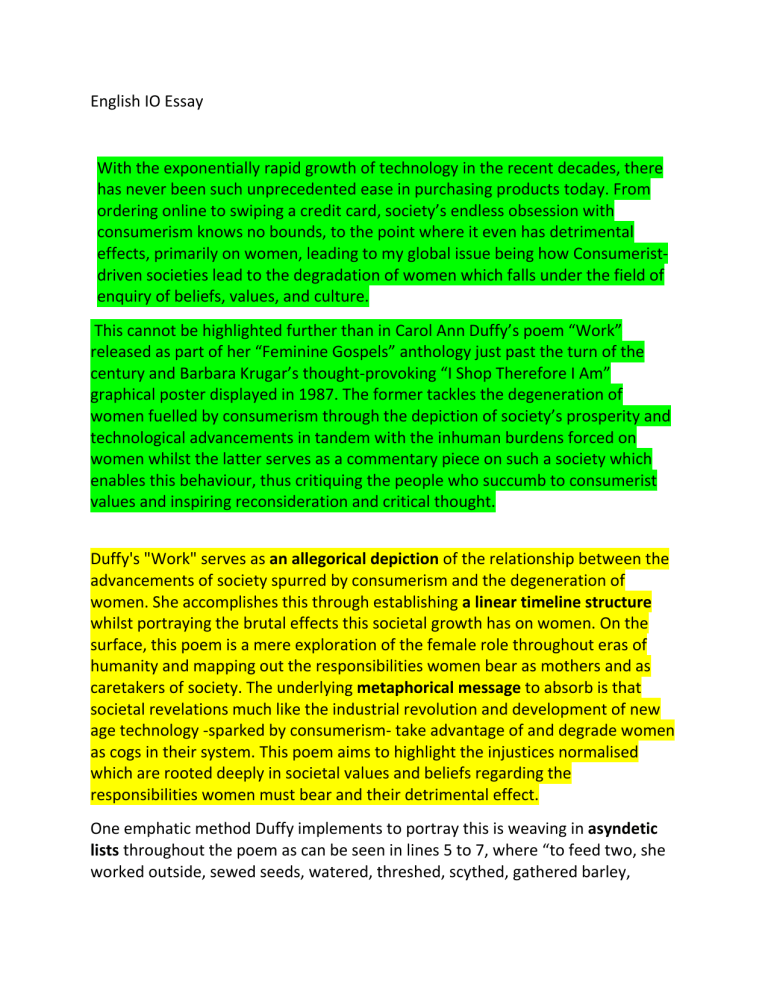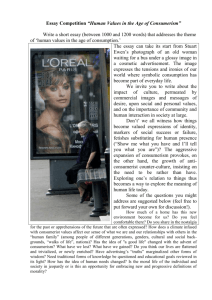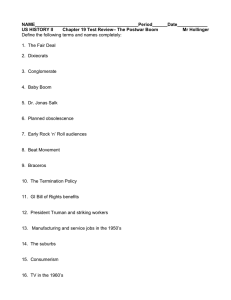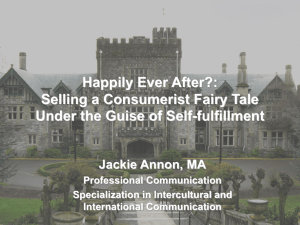
English IO Essay With the exponentially rapid growth of technology in the recent decades, there has never been such unprecedented ease in purchasing products today. From ordering online to swiping a credit card, society’s endless obsession with consumerism knows no bounds, to the point where it even has detrimental effects, primarily on women, leading to my global issue being how Consumeristdriven societies lead to the degradation of women which falls under the field of enquiry of beliefs, values, and culture. This cannot be highlighted further than in Carol Ann Duffy’s poem “Work” released as part of her “Feminine Gospels” anthology just past the turn of the century and Barbara Krugar’s thought-provoking “I Shop Therefore I Am” graphical poster displayed in 1987. The former tackles the degeneration of women fuelled by consumerism through the depiction of society’s prosperity and technological advancements in tandem with the inhuman burdens forced on women whilst the latter serves as a commentary piece on such a society which enables this behaviour, thus critiquing the people who succumb to consumerist values and inspiring reconsideration and critical thought. Duffy's "Work" serves as an allegorical depiction of the relationship between the advancements of society spurred by consumerism and the degeneration of women. She accomplishes this through establishing a linear timeline structure whilst portraying the brutal effects this societal growth has on women. On the surface, this poem is a mere exploration of the female role throughout eras of humanity and mapping out the responsibilities women bear as mothers and as caretakers of society. The underlying metaphorical message to absorb is that societal revelations much like the industrial revolution and development of new age technology -sparked by consumerism- take advantage of and degrade women as cogs in their system. This poem aims to highlight the injustices normalised which are rooted deeply in societal values and beliefs regarding the responsibilities women must bear and their detrimental effect. One emphatic method Duffy implements to portray this is weaving in asyndetic lists throughout the poem as can be seen in lines 5 to 7, where “to feed two, she worked outside, sewed seeds, watered, threshed, scythed, gathered barley, wheat, corn.” By doing this, Duffy conveys the pressures and responsibilities women absorb through long lists devoid of pauses much like the unrelenting barrage of obstacles and duties women have faced in all eras of society. Zooming in within this asyndetic list, the sibilance in “sewed seeds” connotes slyness and perhaps an undetected feeling of unappreciation for the work women have to do. Focusing on the semantic field of growing and nurturing life, the double entendre here highlights both the familial responsibility women are expected to do in raising families in addition to the agricultural labour the woman here is carrying out. Later on, in lines 24 to 26, “she flogged TVs, designed PCs, ripped CDs, burned DVDs”, the asyndetic list here sheds light on a different aspect which is the quick pace of the new technological age, connoting a lack of a pause or opportunity for women to catch their breaths, furthering hindering, and overworking them. This is further accentuated by the temporary rhyme scheme which hastens the tempo and flow of the poem; representative of the rapidly changing pace of society and perhaps replicates the anxiety women feel caused by the urgent need to catch up, amassing to an alternative psychological degradation. In addition, incorporating technical jargon such as “ripped CDs” and “burned DVDs” exemplifies the developing technological age which opens up a new world full of different responsibilities women face and further progresses the established linear timeline structure of the poem, clearly depicting a correlation between society’s progress and women’s burdens. Notably, in line 36, the titular verb “worked” in conjunction with the ghoulish visual imagery in “to the bone” explicitly shows the physically demanding responsibilities women must take on. Moreover, the previously mentioned theme of urgency and lack of time is further emphasised by the colloquial phrase, “twenty-four seven”, encapsulating the never-ending strain forced on women. In relation to Duffy’s other pieces in her “Feminine Gospels” anthology, “Work” encompasses similar themes surrounding the relationship between women and consumerism with “The Woman Who Shopped”, in which a woman falls prey to her insatiable consumerist addiction through shopping, leading to her downfall as she metaphorically devolves from a person into a building, as “she was stone, was concrete and glass” [line 29]. The semantic field of construction connotes development and infrastructural growth, highlighting the parallelism between the advancements of society and the simultaneous deterioration of women who fall prey to their consumerist urges. Alternatively, “Standing Female Nude” tackles the same issue, in which a woman is degraded through objectification, in the form of a painting, in the aims of being valued as a monetary asset to be sold in a museum and “represented analytically” [line 5]. When it comes to Duffy’s execution in her bodies of work, she often transitions her poems from realism to the hyperbolic to emphasise her exaggeration in the aims of highlighting the deep importance of her subject matter in conjunction with the female gaze to distinctly establish her female-driven perspectives. Moving on, Barbara Krugar's thought-provoking critical graphic designs implement dynamic colour schemes that are symbolic of designer clothing brands, paired with declarative statements in order to criticise consumer-culture and spark a movement of change in our societal beliefs and values. The most prominent technique Kruger displays is her use of scale in shaping the central text box roughly to that of a credit card in the palm of the hand in the background. This symbolic item encapsulates the ease of spending money and accessibility to the consumerism world. By the same token as “the world in the palm of your hand”, Kruger demonstrates the heavy influence money has and how we live in a money-centric world focusing purely on monetary decisions thus spurring the development of civilisation. Alternatively, the notion being placed in the palm of a hand also serves as a form of guidance and activism to the viewer; informing them that the choice to be a part of this consumerist world is literally in their hands. Krugar’s renowned selection of typography further aids in her critique of consumerism as she utilises a replica of popular designer clothing brand “Supreme”’s font, which represents the epitome of needless consumerism. Using this font paired with its signature white-red colour scheme immediately alerts the viewers to the themes of her posters. Additionally, the two main clauses are the same size, connoting that “I am” is equivalent to “I shop”, which reinforces the notion that we are nothing more than just a receipt of our purchases. Furthermore, the selected phrase composition devalues people further as shopping is mentioned prior to establishing one’s existence using the conjunctive adverb “therefore” in between to indicate a clear order, depicting how the prioritisation of consuming neglects personal identity which one could argue is a form of degradation. Additionally, Kruger’s declarative statement is a derivative of Rene Descartes’ famous “I think therefore I am”, which originally served as a testament to self-awareness and existentialism and has now been repurposed into a critical statement in the aims of getting society to reconsider its values considering consumerism’s detrimental effects and furthering Kruger’s activism. Moreover, the composition of the blurry monochromatic background signifies the contrast between the mocking quote and the glorifying representation of consumerism represented by the iconic colour scheme, creating irony. The dull, unclear background framed behind a luxurious, identifiable logo embodies the truth behind consumerism; a bland, unbearable reality masquerading as a fancy appealing sticker full of fantasy and temptation, a theme prevalent in Duffy’s other poem “Money Talks”. On the surface, the growth of society sparked by consumerism appears to be a good thing, represented by the designer branding and the credit cards, but underneath the surface lies the negative effects it has on people, alluding to the dull monochrome background devoid of life. Exploring her additional works, Kruger’s signature use of the Supreme colour scheme brands her entire catalogue as a criticism of our society’s values regarding consumerism and the devaluation of personal identity. The underlying aim of her work could be synonymous with civil activism, where she tries to change the tide of public opinion on consumerist behaviour through the medium of feminist discourse, which is what allows compatibility with Duffy’s anthology. This can be seen in her other unnamed work referred to as “Your body is a battleground” in which a woman’s face is divided in two, with one side turned into a photographic negative. This exemplifies the state of limbo and conflict women are in, tying into the semantic field of battle, which is representative of the conflict between consumerism trying to commoditise women’s bodies and the women themselves trying to gain autonomy and agency. Duffy’s “Work” and Krugar’s famous poster both tackle the same issue but from different angles. One details the arduous responsibilities women have faced for centuries due to consumerism forcing societal growth and how that’s played a role in women’s downfalls, the other critiques the society and its values that enable this detriment on women, and how our consumerist behaviour inadvertently harms others, especially women. In other terms, these two pieces are two sides of the same coin, sharing the same ridge but facing in other directions. The former takes its time to explain and inform the viewers of the timeline of women’s burdens, whilst the latter quickly challenges societal conventions to evoke thought and consideration in the present viewers and bring about change. After witnessing both, I always stop to think twice about what I feel like I have to buy.


